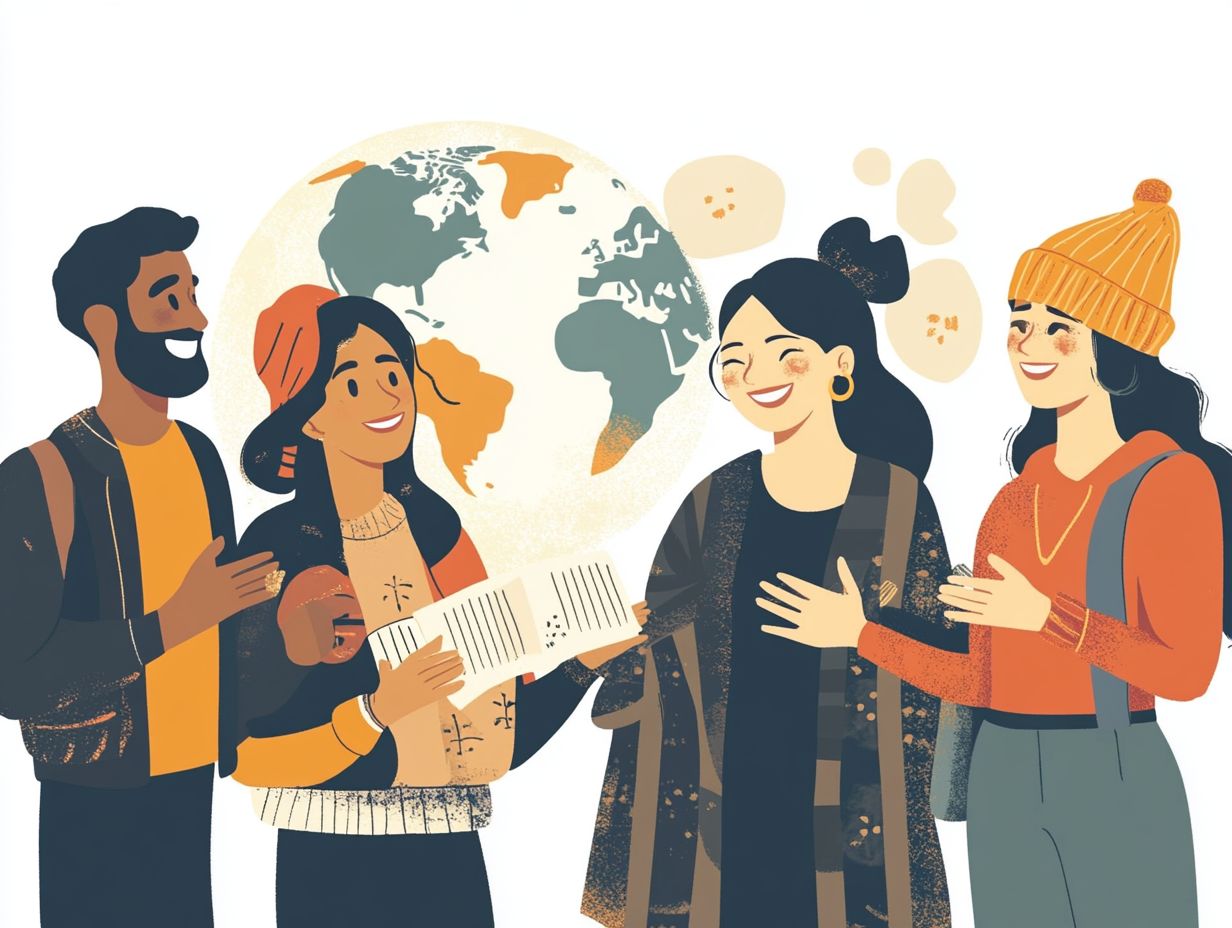What Are the Cultural Etiquette Tips?
Cultural etiquette is vital for fostering understanding and respect across diverse backgrounds.
As you navigate our connected world, knowing how to honor different customs and behaviors becomes essential. This article explores cultural etiquette, highlighting key differences in norms, offering practical tips on what to do and what to avoid, and discussing common missteps that can be easily sidestepped.
Embrace these insights to elevate your relationships and enrich your experiences in various cultural environments. Dive in and discover how to navigate this intricate landscape with confidence and grace!
Contents
- Key Takeaways:
- Understanding Different Cultural Norms
- Tips for Navigating Cultural Etiquette
- Benefits of Practicing Cultural Etiquette
- Common Mistakes to Avoid
- Adapting to New Cultural Environments
- Frequently Asked Questions
- What Are Cultural Etiquette Tips?
- Why is it Important to Know Cultural Etiquette Tips?
- What Are Some Common Cultural Etiquette Tips?
- How Can I Learn About Cultural Etiquette Tips?
- Is It Okay to Make Mistakes When It Comes to Cultural Etiquette?
- What Are Some Cultural Etiquette Tips for Business Interactions?
Key Takeaways:

- Respect and understanding are your best tools for navigating cultural etiquette!
- Research and be aware of different cultural norms and customs before visiting a new country.
- Practicing cultural etiquette improves relationships, avoids offense, and creates a more inclusive and welcoming environment.
What is Cultural Etiquette?
Cultural etiquette refers to the behavioral norms, customs, and traditions that shape social interactions in various societies. It covers everything from greetings and dining manners to gender etiquette and personal space, each of which can vary significantly across regions like the Netherlands, Japan, and Colombia.
Understanding these guidelines is essential for effective cross-cultural communication whether you’re traveling, studying abroad, or engaging with international schools. Misunderstandings can lead to cultural shocks and relationship hurdles, making cultural awareness vital for fostering respect and enriching your travel experiences.
Being attuned to these practices enhances your interpersonal connections and deepens your appreciation for diverse lifestyles. For example, in Japan, bowing is more than just a casual greeting; it embodies respect and an understanding of hierarchy. In contrast, in Colombia, friendly gestures and warmth in conversation highlight the values of hospitality and community.
Travelers who familiarize themselves with such cultural norms navigate social situations with greater ease, minimizing the risk of offending locals and enriching their interactions.
Whether you’re recognizing the significance of eye contact in Western cultures or understanding the importance of shared meals in many African societies, honing your communication skills related to cultural etiquette is invaluable for building meaningful relationships across borders.
Understanding Different Cultural Norms
Grasping the nuances of various cultural norms is vital for anyone seeking to master the intricacies of international interactions, particularly when relocating to new countries or engaging with diverse communities.
These norms encompass practices from tipping etiquette to table manners and public behaviors, all of which can profoundly influence social interactions in places like Germany, Spain, or South Korea.
Understanding these subtleties enhances your experience and fosters deeper connections with those around you.
Key Differences in Customs and Behaviors
Key differences in customs and behaviors often reveal themselves in various aspects of social life, such as greetings, dining practices, and expressions of politeness, each uniquely defined by culture. For instance, the firm handshake standard in the United States contrasts with the bowing commonly practiced in Japan, showcasing the vital role of cultural appropriateness in social settings.
Dining etiquette showcases even more dramatic shifts. In France, meals are a ceremonial experience, with courses served leisurely to promote conversation and savor each flavor. Conversely, in Brazil, friends gather for casual meals where sharing dishes is the norm, embodying camaraderie.
These culinary customs go beyond mere preferences; they fundamentally shape interpersonal communication, fostering connections or leading to misunderstandings. If you appear rushed during a meal in France, it might come off as rude, whereas in Brazil, the emphasis on community and sharing enhances relationships. Grasping these nuances equips you to navigate social interactions more effectively across diverse cultural landscapes.
Start exploring these cultural norms today to enhance your global experiences!

Navigating cultural etiquette requires a proactive mindset. Use these etiquette tips to enhance your interactions and thrive as a frequent traveler or expatriate.
By understanding the behavioral expectations in different contexts, you can significantly improve your communication skills and enrich your travel experiences. Whether you re savoring a meal in Brazil or mingling at a social gathering in Turkey, this understanding is crucial.
Do’s and Don’ts in Different Cultures
Understanding the Do’s and Don’ts across cultures can be a game changer for building positive relationships and avoiding potential missteps. For example, while tipping is common in the United States, many countries, like Japan, view it as unnecessary, showcasing the diverse standards of global etiquette.
Dining etiquette varies widely. In Italy, finishing every bite on your plate is a compliment to the chef, while in some Middle Eastern countries, leaving food may imply you ve been offered too much.
Don t overlook public behavior. In many Asian nations, public displays of affection might be frowned upon, contrasting with the more liberal attitudes found in Western societies.
By being mindful of these cultural distinctions, you enhance your interpersonal connections and cultivate mutual respect. This approach makes it easier to navigate the rich tapestry of global cultures.
Benefits of Practicing Cultural Etiquette
Practicing cultural etiquette offers a wealth of benefits, especially for improving relationships and avoiding misunderstandings in multicultural environments. By showcasing your cultural understanding and respect, you can explore the customs and traditions of diverse countries like Greece, India, and Australia.
This approach enriches your travel experiences and fosters genuine connections with the local cultures you encounter.
Improving Relationships and Avoiding Offense
Improving your relationships and avoiding offense in cross-cultural contexts demands a nuanced understanding of cultural shocks and their impact on social interactions. By honing your awareness of cultural gestures and communication styles, you can skillfully navigate potential misunderstandings, creating a more respectful environment.
Personal space varies dramatically across cultures. In some countries, standing close during conversations conveys warmth and engagement, while in others, it might feel invasive. A simple misstep in respecting these boundaries can lead to discomfort.
Mastering the unspoken rules of greetings like the traditional bow in Japan or a firm handshake in Western cultures can make a huge difference in your interpersonal connections.
By cultivating a keen awareness of these subtleties, you can mitigate the risks of cultural missteps, ultimately nurturing stronger, more empathetic relationships.
Common Mistakes to Avoid

Being mindful of common mistakes and cultural missteps can spare you from discomfort and embarrassment during your travels.
Language barriers can complicate interactions. Understanding the behavioral expectations in various cultures can significantly reduce the risk of inadvertently offending others.
Examples of Cultural Missteps
Cultural missteps can range from the innocuous, like forgetting to remove your shoes in a Japanese home, to the more serious, such as discussing politics in sensitive countries. These blunders highlight the importance of understanding small differences in culture and international customs to navigate diverse environments with finesse.
For example, in many Middle Eastern cultures, displaying the soles of your feet can be seen as quite disrespectful, potentially causing unintended offense. Neglecting to greet someone with the appropriate level of respect in a formal Chinese context can undermine your professional relationships.
Such misjudgments can lead to strained interactions or misunderstandings. They may even result in the loss of valuable business opportunities.
To avoid these pitfalls, immersing yourself in cultural education is essential. This can involve:
- Consulting guides
- Attending workshops
- Engaging in open conversations with locals
Start taking these steps now to enjoy respectful and meaningful interactions!
Adapting to New Cultural Environments
Successfully adapting to new cultural environments involves embracing strategies that allow you to adjust to local customs and practices while remaining true to your personal values.
Whether you’re relocating to England or diving into the rich traditions of South Korea, this journey demands a spirit of openness and a genuine willingness to learn.
Strategies for Adjusting and Learning
Effective strategies for navigating and adapting to new cultural environments involve using travel resources and honing your communication skills. This helps you foster relationships and gain valuable insights.
Engaging with locals, attending cultural events, and exploring etiquette lessons can offer enriching experiences and a deeper understanding of the culture.
Immersing yourself in the local language through language learning apps or classes can significantly ease your transition and help you form meaningful connections.
Participating in workshops centered around cooking, art, or music can further enhance your appreciation for the culture while providing an excellent opportunity to meet new friends.
Utilizing travel resources such as guides or community forums can reveal hidden gems and insider tips that elevate your overall experience. Embrace a mindset of continuous learning whether through reading, observing, or engaging in conversation. This approach will enrich your journey and help cultivate a sense of belonging in a new and exciting land.
Frequently Asked Questions
What Are Cultural Etiquette Tips?
Cultural etiquette tips are guidelines on how to behave respectfully and appropriately when interacting with people from different cultures.
Why is it Important to Know Cultural Etiquette Tips?
Knowing cultural etiquette tips helps avoid misunderstandings and conflicts, and shows respect for other cultures.
What Are Some Common Cultural Etiquette Tips?
Some common cultural etiquette tips include being aware of personal space, using appropriate greetings and titles, and showing respect for elders.
How Can I Learn About Cultural Etiquette Tips?
You can learn about cultural etiquette tips by researching online, reading books, or attending cultural events and workshops.
Is It Okay to Make Mistakes When It Comes to Cultural Etiquette?
Yes, it is okay to make mistakes as long as you are willing to learn and apologize for any unintentional offenses.
What Are Some Cultural Etiquette Tips for Business Interactions?
Some cultural etiquette tips for business interactions include researching the cultural norms of the country you will be doing business with, being punctual, and being mindful of gift-giving customs.
Dive into learning about cultural etiquette today for a richer travel experience!






